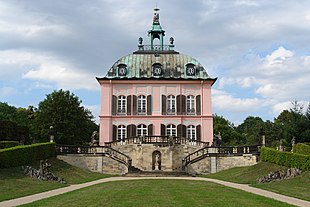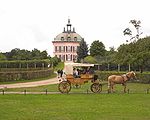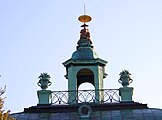Pheasant Castle (Moritzburg)
The pheasant castle is in the Moritzburg community near Dresden . It is located in the pheasantry of the Moritzburg castle park, which was laid out in 1728 . The castle is located on the Niederen Großteich Bärnsdorf near the Moritzburg lighthouse . It is visually connected to Moritzburg Castle , 2.5 kilometers away and exactly to the west, through a visual axis .
History and equipment
The pheasant castle was presumably built in the Rococo style with baroque architectural elements by the court architects Johann Daniel Schade and Johann Gottlieb Hauptmann between 1769 and 1782. A single-storey pavilion, which had already been built in the same place between 1738 and 1739, was extended and rebuilt in the Chinese style . Shortly afterwards, the facility was supplemented by the Garnhaus, the Venusbrunnen, a residential building for Count Marcolini and a maritime facility with a harbor, pier and lighthouse at the Niedere Großteich Bärnsdorf .
The Fasanenschlösschen is a square building with two floors. There are baroque staircases on the south and east sides. The more distant staircase leading to the south is lined with putti . It stands at the upper end of a water axis in the extensive park that points to Moritzburg Castle. The paths leading to the pheasant castle are accompanied by sandstone figures.
The interior is equipped as a country estate with all the necessary functional areas. The work cabinet, living room, bedroom and toilet room as well as an anteroom were on the ground floor. A tea and coffee kitchen was also housed here; the actual court kitchen was in the neighboring house. The upper floor houses the dining room, the largest room in the building. There were servants' rooms in the attic.
The pheasant castle was used by King Friedrich August I of Saxony as a summer residence.
Until 1945 the little pheasant castle was owned by the Wettins . Until 1996 it was used as an ornithological branch of the Dresden Zoo .
present
Today (2018) there is a museum use through guided tours of the premises. Furniture, wallpaper and contemporary accessories from different eras are on display.
Pheasant breeding played a major role in the history of the castle of the same name. Even before the time of Augustus the Strong there were pheasants at this point. Up until 1916, pheasant breeding can be proven throughout. Since 2006, pheasant breeding in the espalier gardens has tried to build on earlier successes.
The Fasanenschlösschen is one of 24 objects belonging to the State Enterprise State Palaces, Castles and Gardens of Saxony .
Views
See also
literature
- Georg Dehio: Handbook of the German art monuments, Saxony . Deutscher Kunstverlag, Munich / Berlin 1990, ISBN 3-422-03016-6 .
Web links
Coordinates: 51 ° 10 ′ 5 " N , 13 ° 42 ′ 23" E




